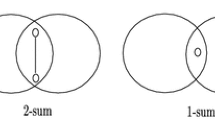Abstract
Many combinatorial optimization problems are solved by a sequence of network flow computations on a network whose edge capacities are given as a function of a parameter λ. Recently Galloet al. [7] made a major advance in solving such parametric flow problems. They showed that for an important class of networks, calledmonotone parametric flow networks, a sequence ofO(n) flow computations could be solved in the same worst-case time bound as a single flow. However, these results require one of two special assumptions: either that the λ values are presented in increasing or decreasing order; or that the edge capacity functions are affine functions of λ. In this paper we show how to remove both of these assumptions while obtaining the same running times as in [7]. This observation generalizes and unifies the two major results of [7], and allows its ideas to be applied to many new combinatorial problems. Of greatest importance, it allows the efficient application of binary search and successive binary search to a sequence of network flow problems.
Similar content being viewed by others
References
R. Ahuja, J. Orlin, C. Stein, and R. E. Tarjan. Improved algorithms for bipartite network flow. Unpublished manuscript, 1989.
T. Y. Cheung. Multifacility location problem with rectilinear distance by the minimum-cut approach.ACM Transactions on Mathematical Software,6:549–561, 1980.
W. H. Cunningham. Computing the binding number of a graph. Manuscript, July 1988.
M. Eisner and D. Severance. Mathematical techniques for efficient record segmentation in large shared databases.Journal of the Association for Computing Machinery,23:619–635, 1976.
L. R. Ford and D. R. Fulkerson.Flows in Networks. Princeton University Press, Princeton, NJ, 1962.
D. Gale and L. S. Shapley. College admissions and the stability of marriage.American Mathematical Monthly,69:9–15, 1962.
G. Gallo, M. Grigoriadis, and R. E. Tarjan. A fast parametric network flow algorithm.SIAM Journal on Computing,18:30–55, 1989.
A. Goldberg and R. E. Tarjan. A new approach to the maximum flow problem.Journal of the Association for Computing Machinary,4:136–146, 1988.
D. Gusfield. A Faster Parametric Minimum Cut Algorithm. Technical Report CSE-90-11, Computer Science Division, University of California, Davis, March 1990.
D. Gusfield and R. Irving.The Stable Marriage Problem: Structure and Algorithms. MIT Press, Cambridge, MA, 1989.
A. Hoffman and J. Rivlin. When is a team “mathematically” eliminated? In H. W. Kuhn, editor,Princeton Symposium on Math Programming (1967), Princeton University Press, Princeton, NJ, 1970, pp. 391–401.
R. W. Irving and P. Leather. The complexity of counting stable marriages.SIAM Journal on Computing,15:655–667, 1986.
R. W. Irving, P. Leather, and D. Gusfield. An efficient algorithm for the “optimal” stable marriage.Journal of the Association for Computing Machinery,34:532–543, 1987.
D. E. Knuth.Marriages Stables. Les Presses de l'Université de Montréal, Montreal, 1976.
E. L. Lawler.Combinatorial Optimization: Networks and Matroids. Holt, Rinehart and Winston, New York, 1976.
J. Picard and H. Ratliff. A cut approach to the rectilinear distance facility location problem.Operations Research,26:422–433, 1978.
G. Polyá, R. E. Tarjan, and D. R. Woods.Notes on Introductory Combinatorics. Birkhäuser-Verlag, Basel, 1983.
B. Schwartz. Possible winners in partially completed tournaments.SIAM Review,8:302–308, 1966.
C. Stein. Efficient algorithms for bipartite network flow. Unpublished manuscript, Princeton University, 1987.
H. S. Stone. Critical load factors in two-processor distributed systems.IEEE Transactions on Software Engineering,3:254–258, 1978.
G. Sullivan. Personal communication.
R. E. Tarjan.Data Structures and Network Algorithms. SIAM, Philadelphia, PA, 1983.
V. A. Trubin. Effective algorithm for the weber problem with a rectangular metric.Cybernetics,14:874–878, 1978.
Author information
Authors and Affiliations
Additional information
Communicated by Greg N. Frederickson.
This research was partially supported by Grants CCR-8803704 and CCR-8722848 from the National Science Foundation.
Rights and permissions
About this article
Cite this article
Gusfield, D., Martel, C. A fast algorithm for the generalized parametric minimum cut problem and applications. Algorithmica 7, 499–519 (1992). https://doi.org/10.1007/BF01758775
Received:
Revised:
Issue Date:
DOI: https://doi.org/10.1007/BF01758775




